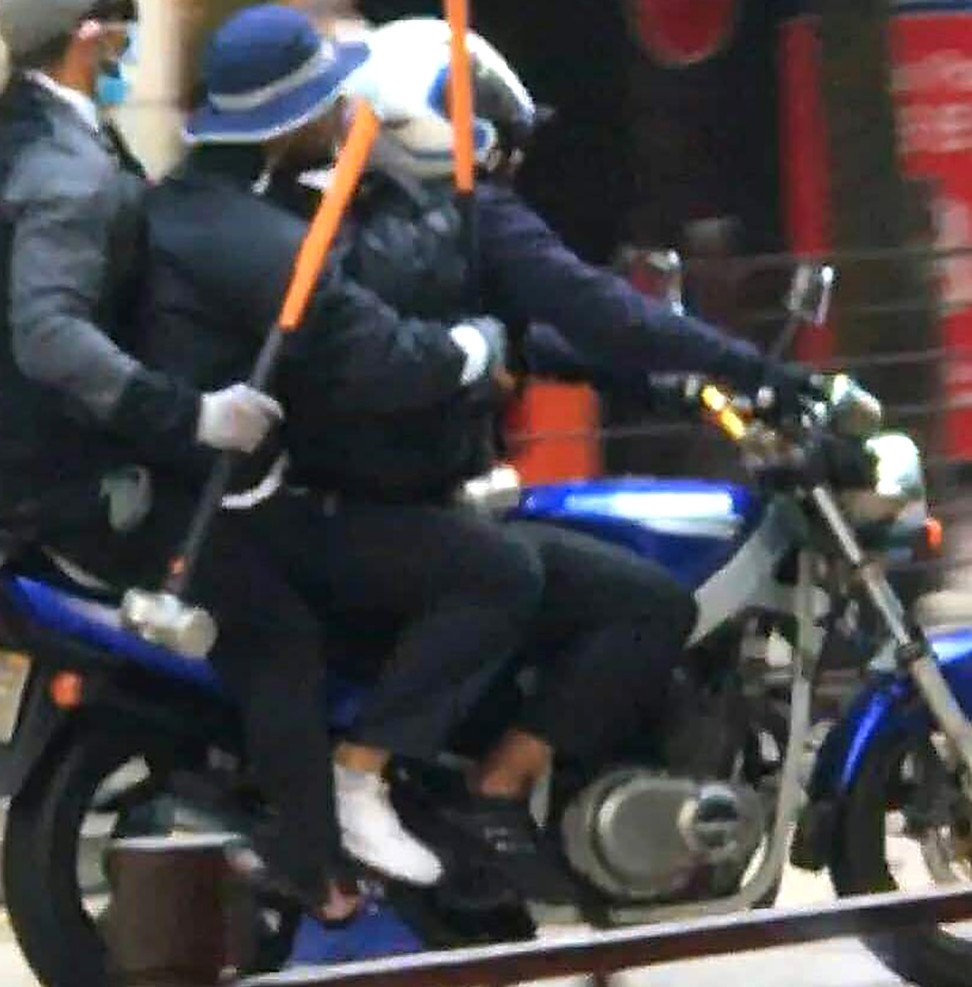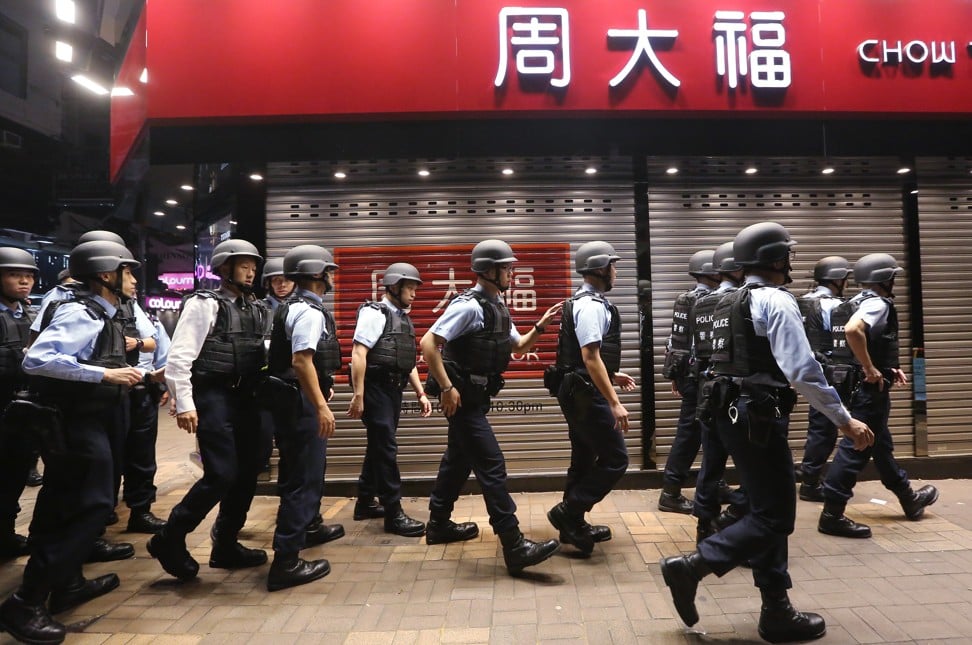
From shoot-outs to smash-and-grab: old-school jewellery raids in era of cybercrime have Hong Kong police on the back foot
The number of robberies may have plummeted since its 1991 peak, but hammer-wielding gangs have in the past year made off with more than HK$70 million in jewellery and valuables
There is a grainy image from more than two decades ago that still reminds Hongkongers of the bad old days, when the city was plagued by an epidemic of audacious jewellery heists.
The television footage shows an armed robber with a balaclava over his head, brandishing an AK-47 assault rifle in broad daylight outside a Mong Kok jewellery shop. The man is widely identified as Yip Kai-foon, the “King of Thieves” who masterminded several of those brazen robberies.

Jewellery retailer Chow Sang Sang’s director of operations, Lau Hak-bun, recalled one such episode in the 1970s.
“I was working as a salesman in Mong Kok one day. The robbers rushed into the shop armed with guns and ordered us to hand over the gold. I was really scared,” he said.

“Gold was the main target of the criminals when the city had an armed robbery every day, because gold could be converted to cash so easily.”
But with ramped-up cross-border police cooperation and tighter security in shops – including guards armed with Remington shotguns – the number of robberies has plunged from 9,138 in 1991 to 163 last year. Police records show there were only three last year involving guns – or “pistol-like objects” as the records refer to them, to include fake guns – compared with 501 in 1991.
But while the statistics show progress in curbing this kind of crime, a closer look at recent cases has revealed how robbers are turning to an old-school modus operandi, putting police – now more used to battling the increasing threat of cybercrime – on the back foot.
And while robbers “eyed watches around a decade ago, now culprits have an appetite for high-end jewellery,” Lau said.
Since March last year, gangs of robbers wielding hammers instead of firearms have made off with more than HK$70 million in jewellery and valuables in six smash-and-grab raids.

They were gone in 60 seconds, taking off on foot and mingling with the crowds in the heart of Hong Kong’s business district. One of them, carrying most of the haul, was caught trying to blend in with the crowd some 600 metres from the jewellery store.
Security consultant and former police superintendent Clement Lai Ka-chi said the robbers were getting smarter.
“The robbers targeted the shop in Central because the area is packed with foreigners of different nationalities,” he said. “Similarly, those who robbed the jewellery shop on Canton Road in Tsim Sha Tsui last year could blend in with the many tourists in the area after the crime. The robberies were well planned.”

Wielding hammers instead of guns reduces the risk of a shoot-out with police, he continued.
“Hammers are also cheaper and are easy to carry,” he said. “You can get a hammer anywhere but you can’t easily buy a gun.”
Lai noted that as the robbery rate took a dive, goldsmiths, banks and jewellers had phased out armed guards as it was expensive to hire them and pay for gun licences. And technological advances meant they could install surveillance systems and alarms that would not sound when triggered but would immediately notify the nearest police unit that a crime was taking place.
Hammers are also cheaper and are easy to carry. You can get a hammer anywhere but you can’t easily buy a gun
But this was precisely why robbers had been emboldened to strike in broad daylight, a veteran detective, speaking on condition of anonymity, said, adding that they also calculate the risks prior to their raids.
“Their raid and escape route is planned. Their action is fast. They do not worry about security alarms because they usually take no more than 30 seconds and they can flee before police arrive,” the detective said.
Indeed, the smash-and-grab cases from last year could easily have been scenes from the Hong Kong film industry’s crime films. That grainy footage of the robber with the AK-47, for example, has been replicated many times in Cantonese cinema.
‘King of Thieves’ Yi forced police to change tactics and beef up arms
The robbers wear masks and caps to conceal their identities and discard the tools of their trade, such as hammers, while fleeing, to throw police off the scent, the detective said.
Over the past week, the Post contacted five jewellery associations to ask how they were ramping up security, but most declined to comment.
A police source said officers from the Crime Prevention Bureau would probably recommend that they make their display windows harder to break by installing an extra layer of reinforced glass.
In addition to surveillance cameras, most jewellery shops would already have motion censors at display windows that would trigger their alarm system.
A police spokesman said the force had stepped up patrols in areas deemed high-risk and strengthened “intelligence-led enforcement actions”.

Police also appealed to shop owners to be vigilant, advising them to minimise the amount of cash and valuables on their premises, install chain-link roller shutters behind glass panels and keep high-value items in secure storage facilities when their shops close for the night, among other precautions.
Lau, who is chairman of the Kowloon Pearls, Precious Stones, Jade, Gold and Silver Ornament Merchants Association, suggested reinforcing shop display windows was not the best way to prevent robberies as it only means burglars have to work harder for a few more seconds to break in.
Their raid and escape route is planned. Their action is fast. They do not worry about security alarms because they usually take no more than 30 seconds and they can flee before police arrive
Also vice-chairman of the Hong Kong Jewellers’ and Goldsmiths’ Association and director of sales operations of Chow Sang Sang, he added that the associations would review security measures with members and offered them advice, including talking to police about security arrangements.
He said hiring armed security guards was popular among jewellery shops in the 1980s and 1990s but their services were no longer needed as it put the safety of staff and citizens at risk, should there be a shoot-out.
Indeed, gangster Yip fell victim a shoot-out – he was left paralysed in May 1996 when a bullet damaged his spine. He was locked up for 41 years, with the term later reduced.
In his recent advisory note to association members, Lau said, he had told them “not to display so many valuables, so the shop looks less tempting [to robbers]”.
“We can bring our guests to the VIP room,” he said. “Also, members should not concentrate all jewellery pieces at one window but to spread them around. It means the robbers have more windows to smash … if they stick around longer to do that, they face a higher risk of getting caught.”



